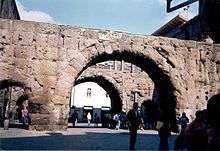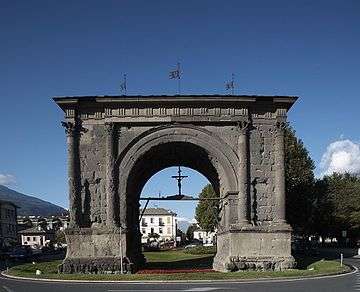Aosta
| Aosta Aoste | ||
|---|---|---|
| Comune | ||
| Città di Aosta Ville d'Aoste | ||
|
Aerial view of Aosta | ||
| ||
 Aosta Location of Aosta in Italy | ||
| Coordinates: IT 45°44′N 7°19′E / 45.733°N 7.317°E | ||
| Country | Italy | |
| Region | Aosta Valley | |
| Province | none | |
| Frazioni | Arpuilles, Beauregard, Bibian, Bioulaz, Borgnalle, Brenloz, Busséyaz, Cache, La Combe, Les Capucins, Chabloz, Champailler, Collignon, Cossan, Cotreau, Duvet, Entrebin, Excenex, Les Fourches, Laravoire, Montfleury, Movisod, Pallin, Papet, Pléod, Porossan, La Riondaz, La Rochère, Roppoz, Saraillon, Saumont, Seyssinod, Signayes, Talapé, Tsanté, Tzambarlet, Vignole | |
| Government | ||
| • Mayor | Bruno Giordano (UV) | |
| Area | ||
| • Total | 21.37 km2 (8.25 sq mi) | |
| Elevation | 583 m (1,913 ft) | |
| Population (30 November 2013)[1] | ||
| • Total | 34,800 | |
| • Density | 1,600/km2 (4,200/sq mi) | |
| Demonym(s) |
Italian: Aostani French: Aostois | |
| Time zone | CET (UTC+1) | |
| • Summer (DST) | CEST (UTC+2) | |
| Postal code | 11100 | |
| Dialing code | 0165 | |
| Patron saint | St. Gratus | |
| Saint day | September 7 | |
| Website | Official website | |
Aosta ([aˈɔsta]; French: Aoste - [ɔst][2][3] Arpitan: Aoûta; Latin: Augusta Prætoria Salassorum) is the principal city of Aosta Valley, a bilingual region in the Italian Alps, 110 km (68 mi) north-northwest of Turin. It is situated near the Italian entrance of the Mont Blanc Tunnel, at the confluence of the Buthier and the Dora Baltea (French: Doire baltée), and at the junction of the Great and Little St. Bernard routes. Aosta is not the capital of the province, because Aosta Valley is the only Italian region not divided into provinces. Provincial administrative functions are instead shared by the region and the communes.
History

Aosta was settled in proto-historic times and later became a centre of the Salassi, many of whom were killed or sold into slavery by the Romans in 25 BC.[4] The campaign was led by Terentius Varro, who then founded the Roman colony of Augusta Praetoria Salassorum, housing 3,000 retired veterans. After 11 BC Aosta became the capital of the Alpes Graies ("Grey Alps") province of the Empire. Its position at the confluence of two rivers, at the end of the Great and the Little St Bernard Pass, gave it considerable military importance, and its layout was that of a Roman military camp.
After the fall of the Western Empire, the city was conquered, in turn, by the Burgundians, the Ostrogoths, the Byzantines. The Lombards, who had annexed it to their Italian kingdom, were expelled by the Frankish Empire under Pepin the Short. Under his son, Charlemagne, Aosta acquired importance as a post on the Via Francigena, leading from Aachen to Italy. After 888 AD it was part of the renewed Kingdom of Italy under Arduin of Ivrea and Berengar of Friuli.
In the 10th century Aosta became part of the Kingdom of Burgundy. After the fall of the latter in 1032, it became part of the lands of Count Humbert I of the House of Savoy.
Main sights
Ancient remains

The ancient town walls of Augusta Prætoria Salassorum are still preserved almost in their entirety, enclosing a rectangle 725 by 571 metres (2,379 by 1,873 ft). They are 6.4 metres (21 ft) high, built of concrete faced with small blocks of stone. At the bottom, the walls are nearly 2.75 metres (9.0 ft) thick, and at the top 1.83 metres (6.0 ft).
Towers stand at angles to the enceinte and others are positioned at intervals, with two at each of the four gates, making twenty towers in total. They are roughly 6.5 metres (21 ft) square, and project 4.3 metres (14 ft) from the wall. Of the 20 original towers, the following are well preserved:
- Tour du lépreux (French for Leper's Tower), which has been given this name after a leper named Pierre-Bernard Guasco was jailed there in the late 17th century. Le lépreux de la cité d'Aoste, a novel by Xavier de Maistre, was named after this leper.
- Tourneuve (13th century).
- Tour du Pailleron.
- Tower (Castle) of Bramafan, built in the 11th century over a Roman bastion. It was the residence of the Savoy viscounts. The Franco-Provençal term Bramafan is translated as "He who screams for hunger".
- Tour du Baillage.
- Tour Fromage.
The east and south gates exist intact. The latter, a double gate with three arches flanked by two towers known as the Porta Praetoria (1st century AD) was the eastern gate to the city, and has preserved its original forms apart from the marble covering.[5] It is formed by two series of arches enclosing a small square.
The rectangular arrangement of the streets is modeled on a Roman plan dividing the town into 64 blocks (insulae). The main road, about 10 metres (33 ft) wide, divides the city into two equal halves, running from east to west. This arrangement makes it clear that guarding the road was the main raison d'être of the city.
The Roman theatre, of which the southern façade remains today, 22 metres (72 ft) tall. The structure, dating from the late reign of Augustus, occupied an area of 81 by 64 metres (266 by 210 ft); it could contain up to 4,000 spectators. In the nearby was the amphitheatre, built under Claudius. A marketplace surrounded by storehouses on three sides with a temple in the centre with two on the open (south) side, as well as a thermae, also have been discovered.
Outside the town walls is the Arch of Augustus, a triumphal arch in honour of Augustus, built in 35 BC to celebrate the victory of consul Varro Murena over the Salassi. About 8 kilometres (5 miles) to the west is a single-arched Roman bridge, called the Pont d'Aël. It has a closed passage, lighted by windows for foot passengers in winter, and above it an open footpath, both being about 10 metres (33 ft) in width.
There are considerable remains of the ancient road from Eporedia (modern Ivrea) to Augusta Praetoria into the Aosta Valley. The modern railway follows this route, notable for the Pont Saint-Martin, which has a single arch with a span of 35 metres (115 ft) and a roadway 4.5 metres (15 ft) wide; the cutting of Donnas; and the Roman bridges of Châtillon (Pont Saint-Vincent) and Aosta (Pont de Pierre).
Other sights
- The Cathedral, built in the 4th century and replaced in the 11th century by a new edifice dedicate to the Madonna. It is annexed to the Roman Forum.
- The Romanesque-Gothic Sant'Orso (Saint-Ours). Its most evocative feature is the cloister, which can be entered through a hall on the left of the façade. It is dedicated to Ursus of Aosta.
- The Saint-Bénin College, built about 1000 by the Benedictines. It is now an exhibition site.
- The Bridge of Grand Arvou, a medieval arch bridge-aqueduct, is located in the frazione of Parossan.
Transport
Aosta railway station, opened in 1886, forms part of the Chivasso–Aosta railway, and is also a junction station for a branch line to nearby Pré-Saint-Didier, in the Valdigne, on the way towards Courmayeur.
Aosta Airport is a short distance to the east of the city.
See also
- Duke of Aosta
- Franco-Provençal language - Valdôtain dialect.
- French language, Aostan French
- Category:Towers in Italy
- Category:Tribes involved in the Gallic Wars
International relations
 Albertville, France[6]
Albertville, France[6] Narbonne, France[6]
Narbonne, France[6] Chamonix-Mont-Blanc, France[6]
Chamonix-Mont-Blanc, France[6] San Giorgio Morgeto, Italy[6]
San Giorgio Morgeto, Italy[6] Sinaia, Romania[6]
Sinaia, Romania[6] Martigny, Switzerland[6]
Martigny, Switzerland[6]
References
- Inline citations
- ↑ Bilancio demografico Anno 2013 Novembre (dati provvisori). Provincia: Valle d'Aosta/Vallée d'Aoste, Istat.
- ↑ Aostan French pronunciation - Jean-Marie Pierret, Phonétique historique du français et notions de phonétique générale, Peeters, Louvain-la-Neuve, 1994, p.|104.
- ↑ Pronounced [ɔst] in Aostan French, [aˈɔst] in standard French.
- ↑ John Lemprière, Lorenzo DaPonte, & John David Ogilby (1839), Bibliotheca Classica: Or, A Dictionary of All the Principal Names and Terms, (Tenth American Edition), New York: W.E. Dean. Salassi, p. 281
- ↑ Toy, Sidney. Castles: Their Construction and History. New York: Dover Publications, 1985. p. 30.
- 1 2 3 4 5 6 7 Annuaire-Mairie.fr. "Ville d'Aoste" (in French). Retrieved 2013-06-18.
- General references
 This article incorporates text from a publication now in the public domain: Chisholm, Hugh, ed. (1911). "Aosta". Encyclopædia Britannica (11th ed.). Cambridge University Press.
This article incorporates text from a publication now in the public domain: Chisholm, Hugh, ed. (1911). "Aosta". Encyclopædia Britannica (11th ed.). Cambridge University Press.
Further reading
- Lin Colliard, La vieille Aoste, éd. Musumeci, Aoste, 1972.
- Aimé Chenal, Promenade archéologique de la ville d'Aoste, ITLA, Aoste, 1965.
- Mauro Caniggia Nicolotti & Luca Poggianti, Aoste inconnue : traces cachées, oubliées ou invisibles de la vieille ville, typog. La Vallée, Aoste, 2010.
- Carlo Promis, Le antichità di Aosta, (Turin, 1862);
- Édouard Bérard, Atti della Società di Archeologia di Torino, iii. 119 seq.; Notizie degli Scavi, passim.
External links
| Wikimedia Commons has media related to Aosta. |
- Virtual Museum Vallée (VMV), virtual museum of Aosta city
- Augusta Praetoria Site plan & photos from the Aosta Valley Regional Authority.
- Ancient Places TV: HD Video of Aosta, Italy
| ||||||
|


